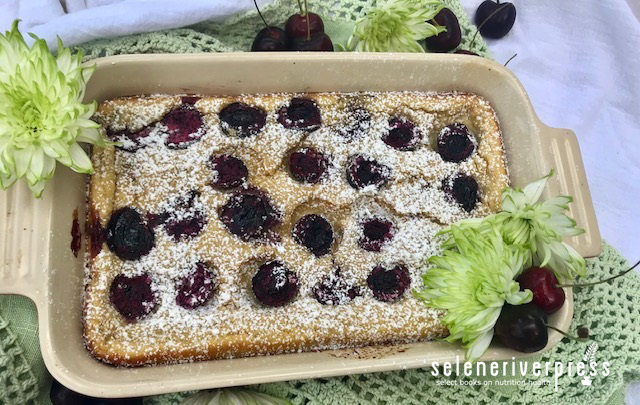I remember the first time I had clafoutis (KLA-foo-tee). I must have been around thirteen, and the bakery where I worked had just received a shipment of plump, deep, burgundy cherries from the Okanagan, in British Columbia. My mentor Pascal immediately exclaimed that I simply had to try clafoutis, so he got to work whipping one up—without a recipe.
In mere minutes, I kid you not, we were sliding a small, shallow pan filled with thick, delicately sweet custard and dotted with the fresh cherries into the oven. And within the hour, we were savoring its light, creamy texture, bursting with warm cherry juice.
A distinctly French dessert of fruit surrounded by a thick, flan-like batter, clafoutis holds a place in my heart not only for the warm nostalgia I feel for it, but also for its perfect melding of simplicity and sophistication. Elegant yet insanely easy, you can literally put it together in under ten minutes and bake it while you eat dinner.
Customarily served warm, clafoutis puffs up like a souffle in the oven, leaving browned crispy edges and a creamy center. And, like a souffle, it will start deflating as soon as you remove it from the oven. With that said, though it’s nice to serve immediately, it’s equally delicious once it starts falling. Though this view is unconventional, I also really enjoy it cold. You can slice it and eat it straight out of hand once it sets.
The dessert hails from the Limousin region of France and—at least according to the time-honored recipe—is made with unpitted cherries. This may sound strange to some, but there’s a reason behind the peculiar practice. The pits contain the active chemical found in almond extract (benzaldehyde), which adds a distinct almond note to the flavor.
Being a faithful Frenchman, of course Pascal’s rendition of the first clafoutis I ever tried contained the pits. I thought it was weird, but I actually kind of enjoyed them. And it certainly was easier to prepare than if we had removed them first. However, most of us today might find it odd, or at the very least inconvenient, to have to spit cherry pits out whilst savoring such a delicate dessert. For that reason, I’ve chosen to cut the cherries in half and remove the pits. I add a heady dose of almond extract to the custard to mimic the original flavor.
In my classic style, I’ve tweaked the ingredients to make it more nutritionally appropriate. Out with the refined white flour and sugar and in with the healthier alternatives. To emphasize the almond impression, almond flour seemed like the perfect substitution, especially since it’s also a frequent ingredient in classical French desserts. Use any alternative sweetener that you like, though do keep in mind that a dark sweetener, like coconut or rapadura sugar, will darken the final product.
Clafoutis lends itself well to variations of almost any fruit imaginable. In addition to cherries, you can use any fresh berries or even ripe stone fruit such as peaches in the height of summer. Apples and pears with a dash of warm spices like nutmeg and cinnamon would be excellent in the fall. Cranberries, or even chocolate and nuts, would make an exceptional dessert in the winter. Use this recipe as a base and experiment to your heart’s content!
Serve clafoutis warm or cold, with an additional dollop of whipped cream if desired.
Cherry Clafoutis
Serves 6
Prep time: 15 minutes
Bake time: approximately 45 minutes
Ingredients
Butter (for pan)
1 cup milk or light cream
¼ cup heavy cream
3 eggs
½ cup honey, inositol, coconut sugar, maple syrup, or other sweetener of choice
1 tablespoon vanilla extract
½ teaspoon almond extract
1 pinch salt
¾ cup almond flour
2 heaping cups sweet or sour cherries, cut in half, pits removed (if desired)
Instructions
- Preheat oven to 350°F. Butter a casserole dish, cast iron pan, or a pie dish at least 1½ inches deep. Set aside.
- Whisk together milk, heavy cream, eggs, sweetener, both extracts, salt, and almond flour in a large bowl. Pour batter into prepared pan. Arrange cherries artfully on top of batter (some might sink, and that’s okay).
- Place in center of oven and bake until puffed and just set with a slight jiggle in the center, about 40–55 minutes. For best results, serve immediately.
Image from Briana Goodall.



